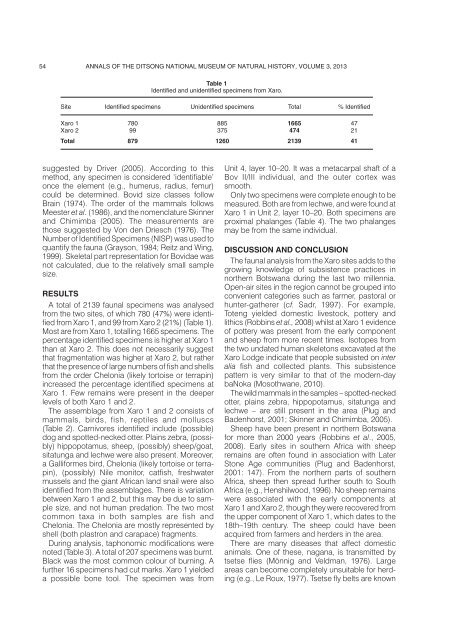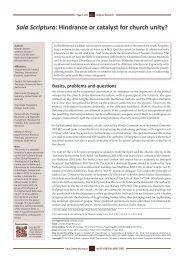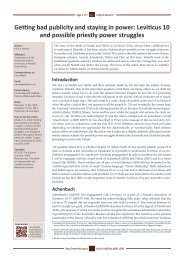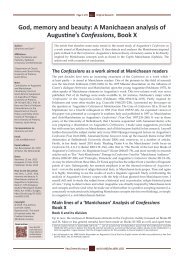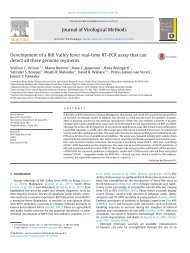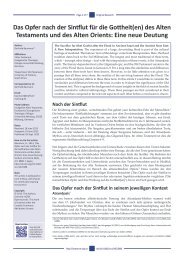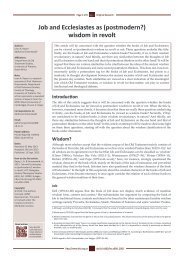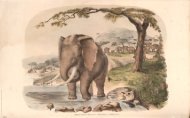View/Open - University of Pretoria
View/Open - University of Pretoria
View/Open - University of Pretoria
You also want an ePaper? Increase the reach of your titles
YUMPU automatically turns print PDFs into web optimized ePapers that Google loves.
54 ANNALS OF THE DITSONG NATIONAL MUSEUM OF NATURAL HISTORY, VOLUME 3, 2013<br />
Table 1<br />
Identified and unidentified specimens from Xaro.<br />
Site Identified specimens Unidentified specimens Total % Identified<br />
Xaro 1 780 885 1665 47<br />
Xaro 2 99 375 474 21<br />
Total 879 1260 2139 41<br />
suggested by Driver (2005). According to this<br />
method, any specimen is considered ‘identifiable’<br />
once the element (e.g., humerus, radius, femur)<br />
could be determined. Bovid size classes follow<br />
Brain (1974). The order <strong>of</strong> the mammals follows<br />
Meester et al. (1986), and the nomenclature Skinner<br />
and Chimimba (2005). The measurements are<br />
those suggested by Von den Driesch (1976). The<br />
Number <strong>of</strong> Identified Specimens (NISP) was used to<br />
quantify the fauna (Grayson, 1984; Reitz and Wing,<br />
1999). Skeletal part representation for Bovidae was<br />
not calculated, due to the relatively small sample<br />
size.<br />
RESULTS<br />
A total <strong>of</strong> 2139 faunal specimens was analysed<br />
from the two sites, <strong>of</strong> which 780 (47%) were identified<br />
from Xaro 1, and 99 from Xaro 2 (21%) (Table 1).<br />
Most are from Xaro 1, totalling 1665 specimens. The<br />
percentage identified specimens is higher at Xaro 1<br />
than at Xaro 2. This does not necessarily suggest<br />
that fragmentation was higher at Xaro 2, but rather<br />
that the presence <strong>of</strong> large numbers <strong>of</strong> fish and shells<br />
from the order Chelonia (likely tortoise or terrapin)<br />
increased the percentage identified specimens at<br />
Xaro 1. Few remains were present in the deeper<br />
levels <strong>of</strong> both Xaro 1 and 2.<br />
The assemblage from Xaro 1 and 2 consists <strong>of</strong><br />
mammals, birds, fish, reptiles and molluscs<br />
(Table 2). Carnivores identified include (possible)<br />
dog and spotted-necked otter. Plains zebra, (possibly)<br />
hippopotamus, sheep, (possibly) sheep/goat,<br />
sitatunga and lechwe were also present. Moreover,<br />
a Galliformes bird, Chelonia (likely tortoise or terrapin),<br />
(possibly) Nile monitor, catfish, freshwater<br />
mussels and the giant African land snail were also<br />
identified from the assemblages. There is variation<br />
between Xaro 1 and 2, but this may be due to sample<br />
size, and not human predation. The two most<br />
common taxa in both samples are fish and<br />
Chelonia. The Chelonia are mostly represented by<br />
shell (both plastron and carapace) fragments.<br />
During analysis, taphonomic modifications were<br />
noted (Table 3). A total <strong>of</strong> 207 specimens was burnt.<br />
Black was the most common colour <strong>of</strong> burning. A<br />
further 16 specimens had cut marks. Xaro 1 yielded<br />
a possible bone tool. The specimen was from<br />
Unit 4, layer 10–20. It was a metacarpal shaft <strong>of</strong> a<br />
Bov II/III individual, and the outer cortex was<br />
smooth.<br />
Only two specimens were complete enough to be<br />
measured. Both are from lechwe, and were found at<br />
Xaro 1 in Unit 2, layer 10–20. Both specimens are<br />
proximal phalanges (Table 4). The two phalanges<br />
may be from the same individual.<br />
DISCUSSION AND CONCLUSION<br />
The faunal analysis from the Xaro sites adds to the<br />
growing knowledge <strong>of</strong> subsistence practices in<br />
northern Botswana during the last two millennia.<br />
<strong>Open</strong>-air sites in the region cannot be grouped into<br />
convenient categories such as farmer, pastoral or<br />
hunter-gatherer (cf. Sadr, 1997). For example,<br />
Toteng yielded domestic livestock, pottery and<br />
lithics (Robbins et al., 2008) whilst at Xaro 1 evidence<br />
<strong>of</strong> pottery was present from the early component<br />
and sheep from more recent times. Isotopes from<br />
the two undated human skeletons excavated at the<br />
Xaro Lodge indicate that people subsisted on inter<br />
alia fish and collected plants. This subsistence<br />
pattern is very similar to that <strong>of</strong> the modern-day<br />
baNoka (Mosothwane, 2010).<br />
The wild mammals in the samples – spotted-necked<br />
otter, plains zebra, hippopotamus, sitatunga and<br />
lechwe – are still present in the area (Plug and<br />
Badenhorst, 2001; Skinner and Chimimba, 2005).<br />
Sheep have been present in northern Botswana<br />
for more than 2000 years (Robbins et al., 2005,<br />
2008). Early sites in southern Africa with sheep<br />
remains are <strong>of</strong>ten found in association with Later<br />
Stone Age communities (Plug and Badenhorst,<br />
2001: 147). From the northern parts <strong>of</strong> southern<br />
Africa, sheep then spread further south to South<br />
Africa (e.g., Henshilwood, 1996). No sheep remains<br />
were associated with the early components at<br />
Xaro 1 and Xaro 2, though they were recovered from<br />
the upper component <strong>of</strong> Xaro 1, which dates to the<br />
18th–19th century. The sheep could have been<br />
acquired from farmers and herders in the area.<br />
There are many diseases that affect domestic<br />
animals. One <strong>of</strong> these, nagana, is transmitted by<br />
tsetse flies (Mönnig and Veldman, 1976). Large<br />
areas can become completely unsuitable for herding<br />
(e.g., Le Roux, 1977). Tsetse fly belts are known


